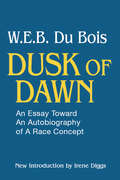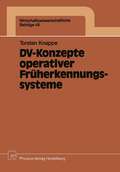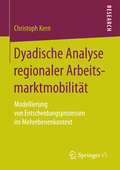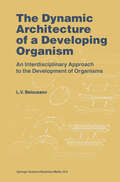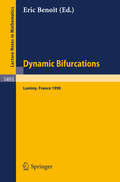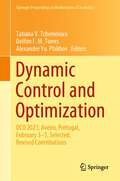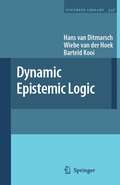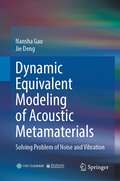- Table View
- List View
Dusk of Dawn!: An Essay Toward an Autobiography of Race Concept (The\library Of America)
by W. E. DuBoisIn her perceptive introduction to this edition, Irene Diggs sets this classic autobiography against its broad historical context and critically analyzes its theoretical and methodological significance.
Dust-Gas Instabilities in Protoplanetary Disks: Toward Understanding Planetesimal Formation (Springer Theses)
by Ryosuke TominagaHow planets form is one of the long-standing questions in astrophysics. In particular, formation scenarios of planetesimals which are kilometer-sized bodies and a precursor of planets are still unclear and under debate although some promising mechanisms have been proposed.This book highlight disk instabilities that have the potential to explain the origin of planetesimals. Using linear analyses and numerical simulations, it addresses how a disk evolves through the development of instabilities, and also presents a new instability driven by dust coagulation. As a result, the simulation demonstrates a scenario of planetesimal formation: A successive development of multiple instabilities triggers planetesimal formation in resulting dusty rings.
DV-Konzepte operativer Früherkennungssysteme (Wirtschaftswissenschaftliche Beiträge #48)
by Thorsten KnappeDyadic Walsh Analysis from 1924 Onwards Walsh-Gibbs-Butzer Dyadic Differentiation in Science Volume 1 Foundations: A Monograph Based on Articles of the Founding Authors, Reproduced in Full (Atlantis Studies in Mathematics for Engineering and Science #12)
by Radomir Stankovic Paul Leo Butzer Ferenc Schipp William R. Wade Weiyi Su Yasushi Endow Sandor Fridli Boris I. Golubov Franz PichlerDyadic (Walsh) analysis emerged as a new research area in applied mathematics and engineering in early seventies within attempts to provide answers to demands from practice related to application of spectral analysis of different classes of signals, including audio, video, sonar, and radar signals. In the meantime, it evolved in a mature mathematical discipline with fundamental results and important features providing basis for various applications. The book will provide fundamentals of the area through reprinting carefully selected earlier publications followed by overview of recent results concerning particular subjects in the area written by experts, most of them being founders of the field, and some of their followers. In this way, this first volume of the two volume book offers a rather complete coverage of the development of dyadic Walsh analysis, and provides a deep insight into its mathematical foundations necessary for consideration of generalizations and applications that are the subject of the second volume. The presented theory is quite sufficient to be a basis for further research in the subject area as well as to be applied in solving certain new problems or improving existing solutions for tasks in the areas which motivated development of the dyadic analysis.
Dyadic Walsh Analysis from 1924 Onwards Walsh-Gibbs-Butzer Dyadic Differentiation in Science Volume 2 Extensions and Generalizations: A Monograph Based on Articles of the Founding Authors, Reproduced in Full (Atlantis Studies in Mathematics for Engineering and Science #13)
by Radomir Stankovic Paul Leo Butzer Ferenc Schipp William R. Wade Weiyi Su Yasushi Endow Sandor Fridli Boris I. Golubov Franz PichlerThe second volume of the two volumes book is dedicated to various extensions and generalizations of Dyadic (Walsh) analysis and related applications. Considered are dyadic derivatives on Vilenkin groups and various other Abelian and finite non-Abelian groups. Since some important results were developed in former Soviet Union and China, we provide overviews of former work in these countries. Further, we present translations of three papers that were initially published in Chinese. The presentation continues with chapters written by experts in the area presenting discussions of applications of these results in specific tasks in the area of signal processing and system theory. Efficient computing of related differential operators on contemporary hardware, including graphics processing units, is also considered, which makes the methods and techniques of dyadic analysis and generalizations computationally feasible.The volume 2 of the book ends with a chapter presenting open problems pointed out by several experts in the area.
Dyadische Analyse regionaler Arbeitsmarktmobilität: Modellierung von Entscheidungsprozessen im Mehrebenenkontext
by Christoph KernChristoph Kern konzeptioniert ein Modell zur Analyse von arbeitsmarktbezogenen Mobilitätsentscheidungen im regionalen sowie partnerschaftlichen Kontext. Dabei wird räumliche Mobilität als das Ergebnis eines dyadischen Entscheidungsprozesses aufgefasst, bei dem neben akteursbezogenen Einflüssen von Individual- und Haushaltsmerkmalen auch Partner- und Kontexteffekte sowie Cross-Level Interaktionen zwischen den Erklärungsebenen zu berücksichtigen sind. Die Umsetzung des Entscheidungsmodells erfolgt mithilfe von mehrebenenanalytischen Strukturgleichungsmodellen, deren Ergebnisse verdeutlichen, dass sich die dyadische Modellstruktur insgesamt als empirisch fruchtbar erweist.
Dynamic Alliance Auctions: A Mechanism for Internet-Based Transportation Markets (Contributions to Management Science)
by Tobias IhdeAn introduction to the new auction format known as ‘Dynamic Alliance Auctions’ which has been developed for Internet-based transportation marketplaces. The format allows for a packagewise placement of transportation orders even if these orders stem from different shippers. This, in turn, increases utilization of truck capacity and reduces risk for carriers. It also results in bringing down transportation prices without shrinking margins. After examining the landscape of Internet-based transportation marketplaces, the book identifies vital characteristics and needs of transportation business. The book shows how Dynamic Alliance Auctions combine ideas of matching theory, auctions and bargaining to fit these needs. Finally, the performance of this auction format is investigated analytically and experimentally using a modified private-value framework and different informational settings.
Dynamic and Stochastic Multi-Project Planning (Lecture Notes in Economics and Mathematical Systems #673)
by Philipp MelchiorsThis book deals with dynamic and stochastic methods for multi-project planning. Based on the idea of using queueing networks for the analysis of dynamic-stochastic multi-project environments this book addresses two problems: detailed scheduling of project activities, and integrated order acceptance and capacity planning. In an extensive simulation study, the book thoroughly investigates existing scheduling policies. To obtain optimal and near optimal scheduling policies new models and algorithms are proposed based on the theory of Markov decision processes and Approximate Dynamic programming. Then the book presents a new model for the effective computation of optimal policies based on a Markov decision process. Finally, the book provides insights into the structure of optimal policies.
The Dynamic Architecture of a Developing Organism: An Interdisciplinary Approach to the Development of Organisms
by L.V. BeloussovFor anybody capable of an emotional response to it, any view of a developing organism should give birth to a feeling of amazement and even admiration, whether this development is seen directly, or in the form of a time lapse film, or even if mentally reconstructed from a series of static images. We ask ourselves how such seemingly primitive eggs or pieces of tissue, without any obvious intervention from outside, so regularly transform themselves into precisely constructed adult organisms. If we try to formulate what amazes us most of all about development, the answer will probably be that it is the internal capacity of developing organisms themselves to create new structures. How, then, can we satisfy our amazement in ways that are more or less reasonable, as well as scientifically valuable? This depends, first of all, on what position we choose to regard embryonic development as occupying among other structure creating processes, even including human activities. On the one hand, one might regard the development of organisms as a highly specialized class of processes, unique to themselves and alien to the general laws of nature, or at least not derivable from them and more akin to the deliberate acts of our own human behaviour. In that case our task would become reduced to a search for some specific 'instructions' for each next member of such a class. Whether in an overt or hidden form, some such ideology seems to dominate in present day developmental biology.
Dynamic Bifurcations: Proceedings of a Conference held in Luminy, France, March 5-10, 1990 (Lecture Notes in Mathematics #1493)
by Éric BenoitDynamic Competitive Analysis in Marketing: Proceedings of the International Workshop on Dynamic Competitive Analysis in Marketing, Montréal, Canada, September 1–2, 1995 (Lecture Notes in Economics and Mathematical Systems #444)
by Steffen Jorgensen Georges ZaccourThis volume contains a selection of papers that were presented at the International Workshop on Dynamic Competitive Analysis, held in Montr6al, Canada, September 1-2, 1995. The workshop was organized by the editors of the proceedings volume. The proceedings contain both "full papers" and shorter pieces, to be considered as "work in progress". The choice of a rather broad theme for the workshop was deliberate and done in order to attract researchers from different areas of the marketing science community that usually do not get together. Obviously, a volume like this cannot be exhaustive in the coverage of the dynamics of marketing competition but we are confident that it will convey to the reader an impression of what are the current themes in this field of research. The book should be useful to researchers in marketing science, applied game theorists, graduate students, as well as practitioners in marketing with an interest in methods and examples of dynamic competitive analysis.
Dynamic Control and Optimization: DCO 2021, Aveiro, Portugal, February 3–5, Selected, Revised Contributions (Springer Proceedings in Mathematics & Statistics #407)
by Delfim F. M. Torres Tatiana V. Tchemisova Alexander Yu. PlakhovThis book contains the revised selected papers of the International Conference on Dynamic Monitoring and Optimization, DCO 2021, held in Aveiro, Portugal, February 3-5, 2021. The papers present achievements in the most challenging areas of dynamic control, optimization and related topics, including recent results in nonlinear dynamic control systems, calculus of variations, sub-Riemannian geometry, conventional differential equations, control of PDE evolution, stochastic differential equations, the spread of acoustic waves in elastic media, dynamics in space-time, Nondegenerate abnormality, controllability, and the infimum gap phenomena in optimization and optimal control with state constraints.
Dynamic Data Analysis: Modeling Data with Differential Equations (Springer Series in Statistics)
by James Ramsay Giles HookerThis text focuses on the use of smoothing methods for developing and estimating differential equations following recent developments in functional data analysis and building on techniques described in Ramsay and Silverman (2005) Functional Data Analysis. The central concept of a dynamical system as a buffer that translates sudden changes in input into smooth controlled output responses has led to applications of previously analyzed data, opening up entirely new opportunities for dynamical systems. The technical level has been kept low so that those with little or no exposure to differential equations as modeling objects can be brought into this data analysis landscape. There are already many texts on the mathematical properties of ordinary differential equations, or dynamic models, and there is a large literature distributed over many fields on models for real world processes consisting of differential equations. However, a researcher interested in fitting such a model to data, or a statistician interested in the properties of differential equations estimated from data will find rather less to work with. This book fills that gap.
Dynamic Data Driven Applications Systems: Third International Conference, Dddas 2020, Boston, Ma, Usa, October 2-4, 2020, Proceedings (Lecture Notes In Computer Science Ser. #12312)
by Erik Blasch Frederica Darema Alex AvedDynamic Decoupling of Robot Manipulators (Mechanisms and Machine Science #56)
by Vigen ArakelianThis book presents the latest results in the field of dynamic decoupling of robot manipulators obtained in France, Russia, China and Austria.Manipulator dynamics can be highly coupled and nonlinear. The complicated dynamics result from varying inertia, interactions between the different joints, and nonlinear forces such as Coriolis and centrifugal forces. The dynamic decoupling of robot manipulators allows one to obtain a linear system, i.e. single-input and single output system with constant parameters. This simplifies the optimal control and accumulation of energy in manipulators. There are two ways to create the dynamically decoupled manipulators: via optimal mechanical design or control.This work emphasises mechatronic solutions. These will certainly improve the known design concepts permitting the dynamic decoupling of serial manipulators with a relatively small increase in total mass of the moving links taking into account the changing payload. For the first time such an approach has been applied on serial manipulators. Also of great interest is the dynamic decoupling control of parallel manipulators. Firstly, the dynamic model of redundant multi-axial vibration table with load has been established, and, secondly, its dynamic coupling characteristics have been analyzed. The discussed methods and applications of dynamic decoupling of robot manipulators are illustrated via CAD simulations and experimental tests.
Dynamic Demographic Analysis (The Springer Series on Demographic Methods and Population Analysis #39)
by Robert SchoenThis volume presents state of the art analyses from scholars dealing with a range of demographic topics of current concern, including longevity, mortality and morbidity, migration, and how population composition impacts intergenerational transfer schemes. New approaches are applied to such issues as measuring changes in cohort survivorship in low mortality populations, patterns of mortality improvement at older ages, and the consequences of heterogeneity in the susceptibility to death. Studies examine models of the current status of the HIV/AIDS epidemic, advance present methods for estimating population change in small areas, and strive to disentangle age, period, and cohort effects. In sum, the book addresses key contemporary issues in measuring and modeling dynamic populations, and advances the frontier of dynamic demography.
Dynamic Documents with R and knitr (Chapman & Hall/CRC The R Series)
by Yihui XieQuickly and Easily Write Dynamic Documents Suitable for both beginners and advanced users, Dynamic Documents with R and knitr, Second Edition makes writing statistical reports easier by integrating computing directly with reporting. Reports range from homework, projects, exams, books, blogs, and web pages to virtually any documents related to statistical graphics, computing, and data analysis. The book covers basic applications for beginners while guiding power users in understanding the extensibility of the knitr package. New to the Second Edition A new chapter that introduces R Markdown v2 Changes that reflect improvements in the knitr package New sections on generating tables, defining custom printing methods for objects in code chunks, the C/Fortran engines, the Stan engine, running engines in a persistent session, and starting a local server to serve dynamic documents Boost Your Productivity in Statistical Report Writing and Make Your Scientific Computing with R Reproducible Like its highly praised predecessor, this edition shows you how to improve your efficiency in writing reports. The book takes you from program output to publication-quality reports, helping you fine-tune every aspect of your report.
Dynamic Documents with R and knitr (Chapman & Hall/CRC The R Series #12)
by Yihui XieQuickly and Easily Write Dynamic Documents Suitable for both beginners and advanced users, Dynamic Documents with R and knitr, Second Edition makes writing statistical reports easier by integrating computing directly with reporting. Reports range from homework, projects, exams, books, blogs, and web pages to virtually any documents related to statistical graphics, computing, and data analysis. The book covers basic applications for beginners while guiding power users in understanding the extensibility of the knitr package. New to the Second Edition A new chapter that introduces R Markdown v2 Changes that reflect improvements in the knitr package New sections on generating tables, defining custom printing methods for objects in code chunks, the C/Fortran engines, the Stan engine, running engines in a persistent session, and starting a local server to serve dynamic documents Boost Your Productivity in Statistical Report Writing and Make Your Scientific Computing with R Reproducible Like its highly praised predecessor, this edition shows you how to improve your efficiency in writing reports. The book takes you from program output to publication-quality reports, helping you fine-tune every aspect of your report.
Dynamic Economic Problems with Regime Switches (Dynamic Modeling and Econometrics in Economics and Finance #25)
by Josef L. Haunschmied Raimund M. Kovacevic Willi Semmler Vladimir M. VeliovThis book presents the state of the art in the relatively new field of dynamic economic modelling with regime switches. The contributions, written by prominent scholars in the field, focus on dynamic decision problems with regime changes in underlying dynamics or objectives. Such changes can be externally driven or internally induced by decisions. Utilising the most advanced mathematical methods in optimal control and dynamic game theory, the authors address a broad range of topics, including capital accumulation, innovations, financial decisions, population economics, environmental and resource economics, institutional change and the dynamics of addiction. Given its scope, the book will appeal to all scholars interested in mathematical and quantitative economics.
Dynamic Efficiency and Productivity Measurement
by Elvira Silva Spiro E. Stefanou Alfons Oude LansinkA systematic treatment of dynamic decision making and performance measurement Modern business environments are dynamic. Yet, the models used to make decisions and quantify success within them are stuck in the past. In a world where demands, resources, and technology are interconnected and evolving, measures of efficiency need to reflect that environment. In Dynamic Efficiency and Productivity Measurement, Elvira Silva, Spiro E. Stefanou, and Alfons Oude Lansink look at the business process from a dynamic perspective. Their systematic study covers dynamic production environments where current production decisions impact future production possibilities. By considering practical factors like adjustments over time, this book offers an important lens for contemporary microeconomic analysis. Silva, Stefanou, and Lansink develop the analytical foundations of dynamic production technology in both primal and dual representations, with an emphasis on directional distance functions. They cover concepts measuring the production structure (economies of scale, economies of scope, capacity utilization) and performance (allocative, scale and technical inefficiency, productivity) in a methodological and comprehensive way. Through a unified approach, Dynamic Efficiency and Productivity Measurement offers a guide to how firms maximize potential in changing environments and an invaluable contribution to applied microeconomics.
Dynamic Efficiency and Productivity Measurement
by Elvira Silva Spiro E. Stefanou Alfons Oude LansinkA systematic treatment of dynamic decision making and performance measurement Modern business environments are dynamic. Yet, the models used to make decisions and quantify success within them are stuck in the past. In a world where demands, resources, and technology are interconnected and evolving, measures of efficiency need to reflect that environment. In Dynamic Efficiency and Productivity Measurement, Elvira Silva, Spiro E. Stefanou, and Alfons Oude Lansink look at the business process from a dynamic perspective. Their systematic study covers dynamic production environments where current production decisions impact future production possibilities. By considering practical factors like adjustments over time, this book offers an important lens for contemporary microeconomic analysis. Silva, Stefanou, and Lansink develop the analytical foundations of dynamic production technology in both primal and dual representations, with an emphasis on directional distance functions. They cover concepts measuring the production structure (economies of scale, economies of scope, capacity utilization) and performance (allocative, scale and technical inefficiency, productivity) in a methodological and comprehensive way. Through a unified approach, Dynamic Efficiency and Productivity Measurement offers a guide to how firms maximize potential in changing environments and an invaluable contribution to applied microeconomics.
Dynamic Epistemic Logic (Synthese Library #337)
by Hans van Ditmarsch Wiebe van der Hoek Barteld KooiDynamic Epistemic Logic is the logic of knowledge change. This book provides various logics to support such formal specifications, including proof systems. Concrete examples and epistemic puzzles enliven the exposition. The book also offers exercises with answers. It is suitable for graduate courses in logic. Many examples, exercises, and thorough completeness proofs and expressivity results are included. A companion web page offers slides for lecturers and exams for further practice.
Dynamic Equations and Almost Periodic Fuzzy Functions on Time Scales (Synthesis Lectures on Mathematics & Statistics)
by Chao Wang Ravi P. AgarwalThis book systematically establishes the almost periodic theory of dynamic equations and presents applications on time scales in fuzzy mathematics and uncertainty theory. The authors introduce a new division of fuzzy vectors depending on a determinant algorithm and develop a theory of almost periodic fuzzy multidimensional dynamic systems on time scales. Several applications are studied; in particular, a new type of fuzzy dynamic systems called fuzzy q-dynamic systems (i.e. fuzzy quantum dynamic systems) is presented. The results are not only effective on classical fuzzy dynamic systems, including their continuous and discrete situations, but are also valid for other fuzzy multidimensional dynamic systems on various hybrid domains. In an effort to achieve more accurate analysis in real world applications, the authors propose a number of uncertain factors in the theory. As such, fuzzy dynamical models, interval-valued functions, differential equations, fuzzy-valued differential equations, and their applications to dynamic equations on time scales are considered.
Dynamic Equations on Time Scales: An Introduction with Applications
by Martin Bohner Allan PetersonOn becoming familiar with difference equations and their close re lation to differential equations, I was in hopes that the theory of difference equations could be brought completely abreast with that for ordinary differential equations. [HUGH L. TURRITTIN, My Mathematical Expectations, Springer Lecture Notes 312 (page 10), 1973] A major task of mathematics today is to harmonize the continuous and the discrete, to include them in one comprehensive mathematics, and to eliminate obscurity from both. [E. T. BELL, Men of Mathematics, Simon and Schuster, New York (page 13/14), 1937] The theory of time scales, which has recently received a lot of attention, was introduced by Stefan Hilger in his PhD thesis [159] in 1988 (supervised by Bernd Aulbach) in order to unify continuous and discrete analysis. This book is an intro duction to the study of dynamic equations on time scales. Many results concerning differential equations carryover quite easily to corresponding results for difference equations, while other results seem to be completely different in nature from their continuous counterparts. The study of dynamic equations on time scales reveals such discrepancies, and helps avoid proving results twice, once for differential equa tions and once for difference equations. The general idea is to prove a result for a dynamic equation where the domain of the unknown function is a so-called time scale, which is an arbitrary nonempty closed subset of the reals.
Dynamic Equivalent Modeling of Acoustic Metamaterials: Solving Problem of Noise and Vibration
by Nansha Gao Jie DengThis book derives physical models from basic principles, studies the effect of equivalent models on the dynamic characteristics of phononic crystals and acoustic metamaterials, and analyzes the physical mechanisms behind vibration and noise reduction. It first summarizes the research status of vibration and noise reduction, and research progress in phononic crystals and acoustic metamaterials. Based on this, one-dimensional periodic beam, two-dimensional thin plate with circular hole, and corresponding gradient structures are introduced, and their dynamic characteristics are discussed in detail. Therefore, different equivalent methods for different models are proposed through theoretical analysis, modal analysis and transmission rate analysis. Finally, a Helmholtz-type acoustic metamaterial, i.e. a multi-layer slotted tube acoustic metamaterial, is studied. Aiming at the low-frequency band gap of this model, a theoretical model for solving the inverse problem of acousto-electric analogue equivalent is proposed, and the effect of structural parameters on the low-frequency band gap is studied using this equivalent model. This book closely revolves around how to conduct equivalent research on artificially fabricated periodic structures. The methods and conclusions presented in this book provide a new theoretical basis for the application of artificial woven periodic structures in the field of low-frequency vibration reduction and noise reduction and are also an innovation in the discipline of vibration and noise control. This book is suitable for undergraduate students, graduate students and teachers in vibration and noise majors in universities, and can also provide references for engineering and technical personnel in related fields.
